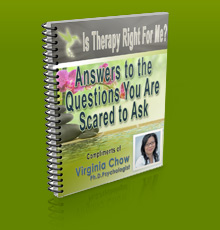
A common reason for consultation by clients in my practice is the experience of having panic attacks. More often than not, they have been referred a doctor after visiting the emergency for fear of having a heart attack.
Therefore, clients’ first reason for seeking help is not necessarily because they suspect that they might be suffering from an anxiety problem but because they fear the worst for their physical health. Given the prevalence of this phenomenon, it becomes important to understand what panic attacks are and how do we make the distinction between a panic attack and a heart attack?
Panic attacks, also known as anxiety attacks, occur when the body suddenly goes into a state of intense fear. Sometimes an anxiety attack is directly related to an obvious trigger, such as public speaking or boarding a plane when there is a fear of flying. Other times, panic attacks may occur when there is no apparent trigger and begins seemingly “out of the blue.”
It is important to consider that panic attacks are relatively short lived, lasting around 30 minutes and peaking after the first 10 minutes before the anxiety begins to subside. However, despite the short duration, sufferers experience intense emotions and often feel as though they are having a heart attack and think they are going to die.
Here’s how you can tell the difference:
During both a panic attack and heart attack, the individual will experience chest pain. How the pain is experienced, on the other hand, will help identify what is occurring within the body.
During a panic attack chest pain is sharp and intermittent, often becoming more intense as the person breathes in or out. Panic attacks may cause a person to feel nauseous however it is rare that someone would vomit during an attack.
During a heart attack chest pain is experienced as a persistent, heavy, crushing feeling on the centre of the chest. The pain may radiate down the left arm, to the neck and the back and if tingling occurs it will usually be located in the left arm.
In addition to the differences in chest pain, other symptoms can distinguish between the two forms of attack. Hyperventilation generally occurs prior to a panic attack but not before a heart attack. If your symptoms resemble those of a heart attack it is important to seek medical attention immediately.
Rest assured that a panic attack will not turn into a heart attack. However, long term suffering from frequent panic attacks may lead to an elevated risk of having a heart attack so it is important to seek anxiety therapy and treatment if you are experiencing panic attacks.
What happens during a panic attack?
When people become stressed, the sympathetic nervous system perceives “danger” and puts into motion a series of changes to prepare the body to protect itself by engaging in a fight or flight response.
For example, the body increases a person’s energy output by triggering a surge of adrenaline, quickening the heartbeat, reducing the amount of oxygen in our blood, and tensing the muscles. In contrast, the parasympathetic nervous system is activated when danger has passed to help return the body to its calmer state.
A problem exists when our mind tends to respond to “perceived” dangers, such as fear of being judged in social situations and losing a job, in similar ways and does not distinguish between a fear of survival and fear of other (usually uncomfortable but harmless) contexts.
This means that the “danger” signal does not always work well in differentiating circumstances but rather works as a general threat system. As a result, we only realize after the fact that the “danger” signal was a false warning signal and that we really didn’t have anything to be afraid of.
During a panic attack, the parasympathetic nervous system fails to activate and the person remains in a state of fear despite the absence of danger. The physical experiences for each person may vary but in general symptoms may include:
· Feeling as though you are losing control or going crazy
· Heart palpitations or pain in the chest
· Difficulty breathing or feeling as though you are choking
· Hyperventilation
· Hot flashes or sudden chills
· Shaking
· Nausea or stomach pain
· Feeling detached from reality
· Feeling like you’re going to faint
Not everyone who experiences anxiety attacks has an anxiety disorder. If your symptoms are disrupting your daily life and/or causing extreme distress, there are some self-help strategies you can use to change your life style and avoid too much anxiety.
Self-Help Strategies
• Self-care; make time in every day to do something relaxing or fun
• Take care of your body; eat healthy
• Avoid too much caffeine, alcohol and nicotine
• Get enough sleep
• Ask for help when you need it
• Journal/Write out your worries
• Practice relaxation techniques such as meditation, stretching or breathing exercises
If your symptoms of panic continue to persist despite the use of these strategies, then it is probably time to consider help. Therapy for the treatment for anxiety can help reduce and eventually eliminate panic attacks. Your psychologist can work with you to set up an individualized treatment plan that will address your specific triggers and emotional needs.
References:
http://www.helpguide.org/mental/anxiety_types_symptoms_treatment.htm
http://www.scientificamerican.com/article.cfm?id=what-happens-in-the-brain-when-we-experience



About the Author:
Dr Chow is a licensed clinical psychologist with a private clinic in Saint-Laurent (Montreal) and in Saint-Lambert on the South Shore. She received her doctorate in Clinical Psychology from Concordia University. She is also a member of the Order of Psychologists of Quebec.